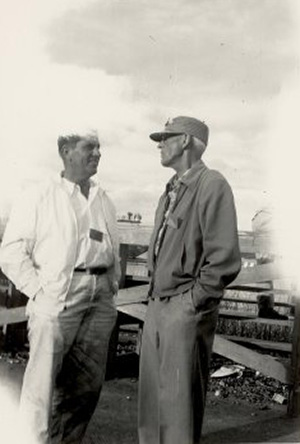Austin Snell

Unlimited hydroplane racing in Seattle during the 1950’s brought considerable acclaim to number of local individuals. Neighboring Tacoma didn’t get in on the hysteria as deeply as Seattle, but from 1957 to 1963, Austin Snell gave his city something to cheer about.
Born in Lewiston, Montana, in 1903, Austin Snell moved to the Pacific Northwest ten years later. He studied at Washington State for three years before going into business for himself selling rebrand gasoline. Realizing the potential of advertising with an unlimited, Snell decided the hydros might be just the thing for him to got in to.
Snell christened his boat Miss Rocket in 1957, then changed it to Coral Reef the following season, in accordance with a name change to his business. The highlight of Coral Reef’s career came in the 1958 Gold Cup, when the craft took a steady second. place overall. But the real fascination with the U-19 lies not with its racing performance, but rather with its experimental powerplant, the German Swedish-built Daimler Benz. The boat simply captured the fancy of anyone with a mechanical heart.
Lloyd Jett was the first to drive the craft, then Bob Larson was going to drive the craft but did not have enough racing time, to be eligible for the Gold Cup. So, Marion Cooper became the driver and he found one problem. The rudder was too long, needed to be shortened by about three inches. George Henley was one of the crewmen.
Coral Reef was one of the first unlimited hydroplanes to run on Lake Coeur d’Alene. Harry Reeves was the driver then. Then in 1960 they changed to Rolls Merlin, which they blew at Lake Pyramid and at Lake Mead.
Just before Christmas on a Sunday night, Rex Bixby phoned that he had found some German engines at Wright-Patterson Air Field. Snell got a hold of Nicholson Electric Co. to bid on the engines for him. Snell got the engines for $25.00 apiece! One was a 601E, the other was a 605. Then Lee Schoenith had a 601N for sale for $700.00.
There were no manuals for the engines. The Swedes had built the engine under contract for the Germans. The Swedes came up with a manual that Snell had a Swedish engineer translate the important parts into English and they got along pretty good after that.
The 601E was the one they converted. The engine was inverted in the aircraft. They turned it up and had to redo the oil system. It scavenged through the valve covers. The oil flow was designed to go in the opposite direction they wanted it to go. The oil was piling up, so they had to put baffles on the inside of the crankcase to rechannel the oil flow. Then they had to install pressure feeds into the valve system and into the camshaft system to compensate for the lack of oil. The only pump that would work was an oil scavenge pump off a 24 cylinder Allison. It ran enough volume.
The 601E engine was a ball-bearing type, so you didn't have any pressure control on the rods. You just poured oil through.
Here was a Bosch fully injection system on the engine, gear driven and laid right in the V of the engine. It had leads to each cylinder. By adjusting, you could regulate the amount of travel of the piston in the injector. The diaphragm then would pull it back and forth to that point,
The engine had a most remarkable blower system. It was oil controlled and variable. You could run it from nothing to 10:1 just by tightening down an oil valve. They were running at 6, possibly 7:1. And were getting all the air pressure they needed. The intake manifold system was very light. To look and feel it you'd think it was thin. But it was a high tensile steel. It was injected. You didn't blow fuel in. Your pressure came from the fuel pump; it was the speed of the fuel pump itself that caused the induction. They ran about 45 inches.
It was one of the best boat engines ever built. It had terrific acceleration, terrific power. It would pick the boat up. It. would throw the boat. It didn't just start to climb, it would just jump.
Then they got into trouble. The boat would climb all right, but you couldn't get back. The injection and induction system were controlled by pressure and vacuum. Later they discovered that the diaphragm was cracked. You could go from a start of of planning — about 60 mph - to 120 in four seconds. Now, that's hard to believe. Bill Muncey was standing on the dock and he said, "How long has that been going on?"
Snell sold his oil company, so had no more advertising to do. Sold the craft to Art Douglas for Art's boy. His kid didn’t work at it, so Art finally sold the craft to Bob Fendler. The engines were sold to Bill Harrah for his museum.
